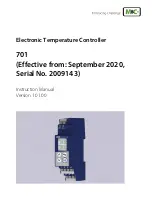
MM4006
M
o
t
i
o
n
Control Tutorial
Relative Error
100%
80%
60%
4(1%
20%
1 2 3 4 5 6 7 8 0
Motion step size (in resolution increments)
Fig. 4.6 — Error vs Motion Step Size.
10 1 1
Fig. 4.6 shows an example of such a plot. The graph represents the maxi-
mum relative error for different motion step sizes. In this example, the
Minimum Incremental Motion that can be reliably performed with a maxi-
mum of 20% error is one equivalent to 4 resolution (encoder) increments.
4.2.7 R e p e a t a b i l i t y
Repeatability is the positioning variation when executing the same motion
profile. Assuming that we have a motion sequence that stops at a number
of different locations, the Repeatability is the maximum variation in posi-
tion all targets when the same motion sequence is repeated a large number
of times. It is a relative, not absolute, error between identical motions.
4.2.8 B a c k l a s h (Hysteresis)
For all practical purposes, Hysteresis and Backlash have the same meaning
for typical motion control systems. The term Hysteresis has an electro-
magnetic origin while Backlash comes from mechanical engineering. Both
describe the same phenomenon: the error caused by approaching a point
from a different direction.
All parameters discussed up to now that involve the positioning Error
assumed that all motions were performed in the same direction. If we try to
measure the positioning error of a certain target (destination), approaching
the destination from different directions could make a significant differ-
ence.
In generating the plot in Fig. 4.2 we said that the motion device will make a
large number of incremental moves, from one end of travel to the other. If
we command the motion device to move back and stop at the same loca-
tions to take a position error measurement, we would expect to get an iden-
tical plot, superimposed on the first one. In reality, the result could be
similar to Fig. 4.7.
(%,
EDI10181En1020 — 03/03
4.8
N
e
w
p
o
r
t
.
Summary of Contents for MM4006
Page 9: ...F D110181En1020 03 03 b J e w p o r t...
Page 11: ...MM4006 8 Axis Motion Controller Driver evvport...
Page 41: ...MM4006 Introduction FPI 111181Eli11120 0 1 03 1 3O tNevvport...
Page 42: ...Section 2 Local Mode C Newport...
Page 43: ...MM4006 8 Axis Motion Controller Driver C N e w p o r t...
Page 96: ...Section 3 Remote Mode C klevvport...
Page 97: ...Newport...
Page 310: ...Section 4 Motion Control Tutorial Ilevvport...
Page 311: ...MM4006 8 Axis Motion Controller Driver C EDI10181En 1020 03 03 2 N e V V p O r t...
Page 313: ...MM4006 8 Axis Motion Controller Driver cv ED110181E01020 03 03 4 2 M e v v p o r t...
Page 334: ...Section 5 Trajectory Functions Tutorial Newport...
Page 335: ...MM4006 8 Axis Motion Controller Driver C Newport...
Page 337: ...MM4006 8 Axis Motion Controller Driver EDH0181En1020 03 03 5 2 N e w p o r t...
Page 346: ...Section 6 Feature Descriptions Tutorial Newport...
Page 347: ...MM4006 8 Axis Motion Controller Driver C Nevvport...
Page 349: ...MM4006 8 Axis Motion Controller Driver ED11018lEn I 020 03 03 6 2 N e v v p O r t...
Page 359: ...MM4006 F e a t u r e Descriptions Tutorial cv EDI10181En1020 03 03 6 12 N e w p o r t...
Page 360: ...Section 7 Servo Tuning rano at 1 2 2 p EOF 110 1 0 0 0 0 0 ill fpL4 cv Newport...
Page 361: ...MM4006 8 Axis Motion Controller Driver C Nevvport...
Page 363: ...MM4006 8 Axis Motion Controller Driver EDH0181En 1020 03 03 7 2...
Page 368: ...Section 8 Appendices INevvport...
Page 369: ...MM4006 8 Axis Motion Controller Driver CkJ Newport...
Page 371: ...MM4006 8 Axis Motion Controller Driver EDI10181EnI020 03 03 8 2 N e v v p o r t...
Page 410: ...A7 h7s z c 7...
















































